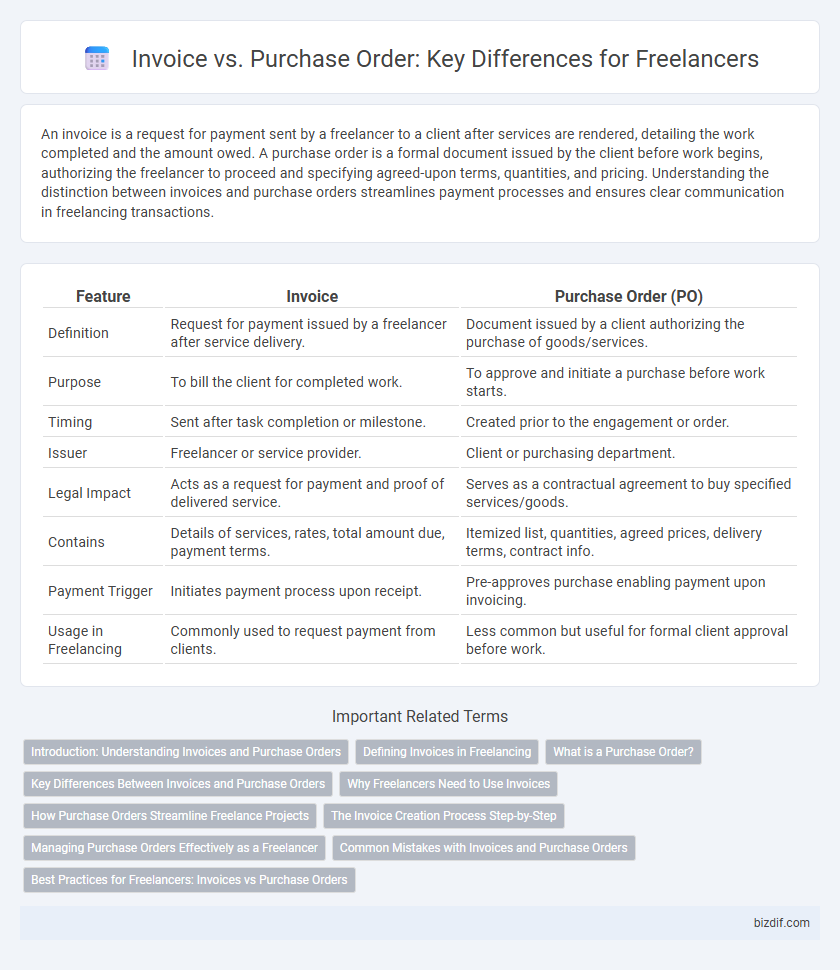An invoice is a request for payment sent by a freelancer to a client after services are rendered, detailing the work completed and the amount owed. A purchase order is a formal document issued by the client before work begins, authorizing the freelancer to proceed and specifying agreed-upon terms, quantities, and pricing. Understanding the distinction between invoices and purchase orders streamlines payment processes and ensures clear communication in freelancing transactions.
Table of Comparison
| Feature | Invoice | Purchase Order (PO) |
|---|---|---|
| Definition | Request for payment issued by a freelancer after service delivery. | Document issued by a client authorizing the purchase of goods/services. |
| Purpose | To bill the client for completed work. | To approve and initiate a purchase before work starts. |
| Timing | Sent after task completion or milestone. | Created prior to the engagement or order. |
| Issuer | Freelancer or service provider. | Client or purchasing department. |
| Legal Impact | Acts as a request for payment and proof of delivered service. | Serves as a contractual agreement to buy specified services/goods. |
| Contains | Details of services, rates, total amount due, payment terms. | Itemized list, quantities, agreed prices, delivery terms, contract info. |
| Payment Trigger | Initiates payment process upon receipt. | Pre-approves purchase enabling payment upon invoicing. |
| Usage in Freelancing | Commonly used to request payment from clients. | Less common but useful for formal client approval before work. |
Introduction: Understanding Invoices and Purchase Orders
Invoices serve as detailed billing documents freelancers issue to clients, specifying services rendered, payment terms, and due dates. Purchase orders are formal client-issued documents authorizing the procurement of services or goods with predefined terms and quantities. Recognizing the distinct roles of invoices and purchase orders streamlines financial transactions and ensures clear communication in freelancing projects.
Defining Invoices in Freelancing
Invoices in freelancing serve as formal documents issued by freelancers to clients, detailing the services provided along with corresponding fees, payment terms, and due dates. These documents are critical for tracking project expenses, ensuring transparent communication, and securing timely payments. Unlike purchase orders that originate from clients to authorize purchases, invoices act as requests for payment, reflecting completed work and agreed-upon financial terms.
What is a Purchase Order?
A purchase order is a formal document issued by a buyer to a freelancer or vendor, specifying details such as quantities, agreed prices, and delivery terms for products or services requested. It serves as a legal contract that authorizes the transaction and ensures clarity on the scope of work before invoicing occurs. In freelancing, purchase orders help streamline payment processes and protect both parties by providing a clear record of the agreed-upon services and costs.
Key Differences Between Invoices and Purchase Orders
Invoices and purchase orders serve distinct functions in freelancing transactions, with invoices being bills sent by freelancers to clients detailing services rendered and payment due, while purchase orders are formal requests issued by clients to authorize work and agree on terms before services begin. Invoices include payment terms, due dates, and itemized costs, whereas purchase orders specify quantities, agreed prices, and approval to proceed. Understanding these key differences ensures freelancers manage billing accurately and maintain clear client agreements.
Why Freelancers Need to Use Invoices
Freelancers need to use invoices to ensure clear payment terms and professional documentation, which helps in tracking project payments and maintaining accurate financial records. Invoices provide specific details about services rendered, payment deadlines, and amounts due, reducing payment disputes and improving cash flow management. Unlike purchase orders, which initiate a purchase agreement, invoices formally request payment and serve as essential legal and accounting documents for freelancers.
How Purchase Orders Streamline Freelance Projects
Purchase orders streamline freelance projects by providing clear, written agreements that outline project scope, deliverables, and payment terms before work begins. This detailed documentation reduces misunderstandings and facilitates smoother communication between freelancers and clients. By establishing a formal approval process, purchase orders help freelancers manage expectations and secure timely payments.
The Invoice Creation Process Step-by-Step
The invoice creation process in freelancing begins with detailing the services provided, including hours worked, rates, and project specifics aligned with the purchase order. Next, freelancers generate a formal invoice document containing unique invoice numbers, payment terms, and client contact details to ensure clarity and professionalism. Finally, the invoice is sent to the client for approval and payment, facilitating smooth financial transactions and accurate record-keeping between freelancer and buyer.
Managing Purchase Orders Effectively as a Freelancer
Managing purchase orders effectively as a freelancer involves clearly understanding the terms and specifications outlined in each purchase order to ensure accurate project delivery and timely payment. Utilizing digital tools like accounting software or purchase order management systems streamlines tracking, reduces errors, and helps maintain organized records for client billing and tax purposes. Maintaining open communication with clients to confirm purchase order details minimizes discrepancies and supports smoother transaction workflows.
Common Mistakes with Invoices and Purchase Orders
Common mistakes with invoices and purchase orders in freelancing include mismatched details such as incorrect client information, inaccurate item descriptions, or wrong pricing, which lead to payment delays. Freelancers often overlook referencing the purchase order number on invoices, causing confusion in transaction tracking and approval processes. Ensuring consistency in dates, quantities, and terms between invoices and purchase orders is essential to maintain smooth communication and timely payments.
Best Practices for Freelancers: Invoices vs Purchase Orders
Freelancers should use invoices to request payment with detailed descriptions of services, payment terms, and due dates, ensuring clear communication and accurate record-keeping. Purchase orders serve as client-issued documents authorizing the work and outlining agreed-upon terms, helping prevent disputes and streamline project approval. Maintaining organized records of both invoices and purchase orders enhances financial management and professionalism in freelance operations.
Invoice vs Purchase Order Infographic

 bizdif.com
bizdif.com